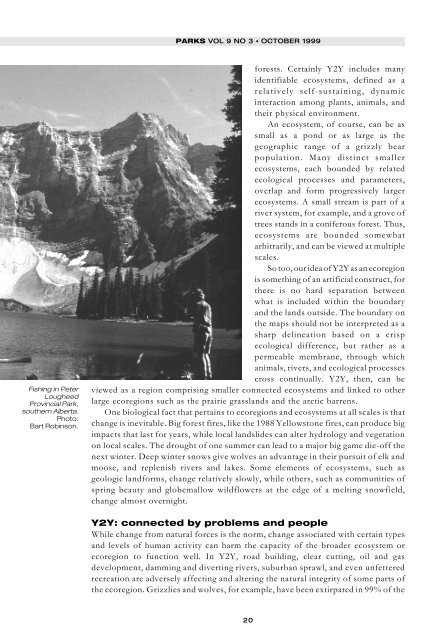Parks - IUCN
Parks - IUCN
Parks - IUCN
You also want an ePaper? Increase the reach of your titles
YUMPU automatically turns print PDFs into web optimized ePapers that Google loves.
Fishing in Peter<br />
Lougheed<br />
Provincial Park,<br />
southern Alberta.<br />
Photo:<br />
Bart Robinson.<br />
PARKS VOL 9 NO 3 • OCTOBER 1999<br />
forests. Certainly Y2Y includes many<br />
identifiable ecosystems, defined as a<br />
relatively self-sustaining, dynamic<br />
interaction among plants, animals, and<br />
their physical environment.<br />
An ecosystem, of course, can be as<br />
small as a pond or as large as the<br />
geographic range of a grizzly bear<br />
population. Many distinct smaller<br />
ecosystems, each bounded by related<br />
ecological processes and parameters,<br />
overlap and form progressively larger<br />
ecosystems. A small stream is part of a<br />
river system, for example, and a grove of<br />
trees stands in a coniferous forest. Thus,<br />
ecosystems are bounded somewhat<br />
arbitrarily, and can be viewed at multiple<br />
scales.<br />
So too, our idea of Y2Y as an ecoregion<br />
is something of an artificial construct, for<br />
there is no hard separation between<br />
what is included within the boundary<br />
and the lands outside. The boundary on<br />
the maps should not be interpreted as a<br />
sharp delineation based on a crisp<br />
ecological difference, but rather as a<br />
permeable membrane, through which<br />
animals, rivers, and ecological processes<br />
cross continually. Y2Y, then, can be<br />
viewed as a region comprising smaller connected ecosystems and linked to other<br />
large ecoregions such as the prairie grasslands and the arctic barrens.<br />
One biological fact that pertains to ecoregions and ecosystems at all scales is that<br />
change is inevitable. Big forest fires, like the 1988 Yellowstone fires, can produce big<br />
impacts that last for years, while local landslides can alter hydrology and vegetation<br />
on local scales. The drought of one summer can lead to a major big game die-off the<br />
next winter. Deep winter snows give wolves an advantage in their pursuit of elk and<br />
moose, and replenish rivers and lakes. Some elements of ecosystems, such as<br />
geologic landforms, change relatively slowly, while others, such as communities of<br />
spring beauty and globemallow wildflowers at the edge of a melting snowfield,<br />
change almost overnight.<br />
Y2Y: connected by problems and people<br />
While change from natural forces is the norm, change associated with certain types<br />
and levels of human activity can harm the capacity of the broader ecosystem or<br />
ecoregion to function well. In Y2Y, road building, clear cutting, oil and gas<br />
development, damming and diverting rivers, suburban sprawl, and even unfettered<br />
recreation are adversely affecting and altering the natural integrity of some parts of<br />
the ecoregion. Grizzlies and wolves, for example, have been extirpated in 99% of the<br />
20

















